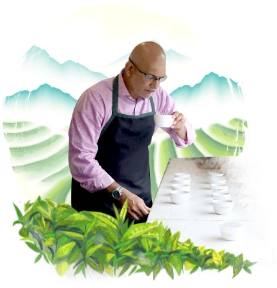Tea-Bags…In a Hundred Years
The ubiquitous, unassuming and humble tea-bag that we almost unthinkingly and instinctively use to make a cup of our favorite tea is over a hundred years old! It was the biggest invention in tea in the twentieth century – one that revolutionized tea drinking from cumbersome to convenient, clean and consistent.
Join us as we revisit the first patent granted for a hand-sewn tea-bag to the invention of the filter paper and tea-bag machines to the latest pyramid tea-bags that bring the best of quality and convenience in what is truly a technological marvel.
The First Patented for Tea-Bags
The first recorded patent for what we now know as tea-bag was granted in 9903 to Roberta C. Lawson and Mary McLaren of Milwaukee, Wisconsin. The apparatus was actually called a Tea Leaf Holder. It was actually a hand-sewn pocket made with mesh fabric such as muslin or cotton. The pocket also had a flap through which small quantity of tea-leaves could be inserted, after which, it was closed using a thin wire. comprised of a pocket made of open mesh fabric, such as cotton thread. According to the patent granted, the Tea Leaf Holder was “to provide means whereby a small quantity of tea, so much only as is required for a single cup of tea, can be placed in a cup and have water poured thereon to produce only a cup of tea fresh for immediate use”. This was the first time that tea could be brewed not by the pot, but for an individual serving.
Thomas Sullivan Accidentally Popularises Tea-Bags
The story goes that Thomas Sullivan, a New York tea-importer, decided to send samples of tea to customers in small silk bags to save money. These silk bags were tied with strings. He was sure his customers would open these silk bags and take out the actual tea. But his customers did not bother to do so, and instead, popped the small silk bags directly into hot water. Such was the convenience these bags offered that they soon started to order tea in these ready-to-dip silk bags! While Thomas Sullivan has not invented the tea-bag, he had certainly played an important role in making them popular.
The First Tea-Bagging Machine
For the next two decades, hand-sewn tea-bags made out of cotton or muslin became extremely popular as they provided measured, single-serve, clean and convenient way to brewing tea. But all this was about to be changed with the invention of paper tea-bags :
In the 1930s, Fay H. Osborne, a paper scientist working at Massachusetts Institute of Technology (MIT) invented a process of making porous, long-fiber paper on a continuous basis. He was also granted a patent for this invention.
A few years later, in Germany, a teenager working with Teekanne GmbH – Adolf Rambold, used the long-fiber paper invented by Fay H. Osborne, to successfully create a paper tea-bag. This was probably the first single-chamber tea-bag made with filter paper that we can see even today. Rambold continued to work at Teekanne GmbH, inventing many other tea packing machines, including the tea-bag with wrapper (envelope) machine. However, his most important invention was to come in 1948, when he invented the double-chamber tea-bag for which he was granted a patent in 1952. The double-chamber tea-bag was made with a single piece of paper, and had four surfaces instead of two, allowing more surface area for the water to seep in and for the tea to let out its infusion.
The double chambered tea-bag was introduced in the UK by Tetley. Though not very popular in the early years, tea-bags were destined to change the way the UK drank its teas. In the 1960s, tea-bags only constituted about 3% of UK’s total tea consumption; today, tea-bags account for much as 96% of all tea consumed in the UK. The double-chamber tea bag continued to be the most popular form of tea-bag all over the world for a major part of the twentieth century. It became the de-factor standard for tea-bags for almost forty years and continues to enjoy immense popularity to this day.
The Round Tea Bags
In yet another significant innovation, Tetley UK launched their string-less, tag-less round or circular tea bags in 1989. Made with a filter paper that made more perforations, these round tea-bags were meant to fit snugly to the bottom of the mug (since maximum tea was now being drunk from mugs and not cups), and hence, eliminate the need to take a messy, dripping tea-bag out of the cup. The round tea-bag soon became very popular in the UK.
The Pyramid Tea Bags
In 1997, the pyramid tea-bag was invented by PG Tips. These tea-bags were sealed ultrasonically, something that is a marvel of modern technology. Also called tetrahedral or 3D tea-bags, the unique advantage of these tea-bags is that they offer the maximum volume, thus allowing the long-leaf tea to be used in a tea-bag format for the first time. Till the invention of pyramid tea-bags, all other forms of tea-bags were made out of long-fiber paper (also called filter paper) which necessitated the use of very small grades of tea like fanning and dust. The best flavour of tea always comes from the whole leaf teas, but it was impossible to fill in whole leaves inside paper tea-bags. With pyramid tea-bags, it became possible to pack the top quality whole leaf teas in a tea-bag, making them the first choice for premium teas.
Today, pyramid tea-bags are used for all premium quality teas like Darjeeling Whole Leaf Tea, Long Leaf Green Tea, Leafy Oolong Tea as well as White Tea. In fact, pyramid tea-bags are also used for Turmeric Tea infusions, Masala Chai as well as Chamomiles and Herbal Teas that use real herbs, spices and flowers.
Who would have thought that the humble Tea Leaf Holder created for a “small quantity of tea, so much only as is required for a single cup of tea…” would change the world of tea to such an extent in just a hundred years!

Tea is a religion in the art of life.

